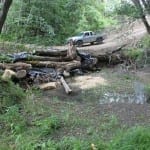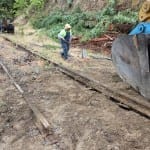Eel River Recovery Work
Yesterday, the Sacramento Bee ran an insightful article on the Eel River, the looming battle for its waters, and the impact water diversions and other factors have had on salmon and steelhead.
At issue is the re-licensing of the river’s (or PG&E’s) Potter Valley Project which includes a mile-long tunnel that began diverting Eel water to the Russian River more than a hundred years ago.
For insight on the issue, Bee reporter Susan Sward looked at three other water battles across the state; the Trinity River, Klamath River and Mono Lake. Each of these have had at least one thing in common — CalTrout’s involvement in fighting for adequate flows and a healthy ecosystem for the state’s wild fish populations.
The potential for consensus on the Eel may exist in the respected Eel River Forum, an effort by CalTrout’s Darren Mierau to bring the affected parties together. The forum’s 22 members include the Sonoma County Water Agency, PG&E, the Potter Valley Irrigation District, Indian tribes, state and federal agencies and environmental groups.
Mierau, CalTrout’s North Coast regional manager, told me: “The river needs help. There is such a great opportunity for a huge recovery of the Eel.”
Bridge Creek Project
In other Eel-related news, construction of the half-million dollar Bridge Creek Fish Passage Project began in earnest last week. Over the next several weeks, this project will remove a 200 fo0t section of the North West pacific Railroad Line that runs along the mainstem Eel River near Scotia, CA, along with more than 30,000 cubic yards of the railroad crossing fill materials that has blocked access to coho salmon and steelhead habitat in Bridge Creek for decades. Progress made includes:
- installed a temporary stream crossing
- laid out fish protection and stream dewatering infrastructure (pipes, hoses, etc.)
- removed approved sections of railroad tracks
- began removing fill dirt and rock from the railroad embankment, a task that will take several weeks to complete. Lots of dirt to move!
The project will wrap-up late this summer, in time to welcome home salmon and steelhead into Bridge Creek for the first time in many, many years.







2 Comments
I am 66 years old, born & raised along the Russian River, caught first steelhead at age eight. That being said, I’ve seen the terrible down grading of our north coast fisheries. It’s so very complex that if I stated the problems that I only know, it would take several paragraphs so I am only addressing the Eel River article.
First of all, the article stated that by removing Scott Dam at Lake Pillsbury would open up to 150 Miles of spawning area for the salmonids. This is an ABSOLUTELY FALSE statement. I know the area and have scaled maps and at best it may open up 50 miles, more like 30 miles of spawning area. I have also been confirmed of my finding with a F&W biologist.
Do the people who stated the incorrect area realize there are falls on the main stem near Bloody Rock that fish can’t pass? Do they really know the area or are they just looking at Quad Maps?
As to water flows, stop the current release program and provide natural flow rates below the diversion dam. This could be easily monitored by putting stream gauges on the main stem, rice fork and salmon creek. The lake could be filled during the heavy winter flooding to be used for summer recreation and diversion water. The release, say March 1st, would be the inflow plus 10% or ? and the amount for diversion. This formula would at least keep things natural below the diversion dam.
The abuse of the watershed needs to stop! The River use near the Bridge above the diversion dam with uncontrolled vehicles on the gravel bars, camping, litter, human waste and pollution has gotten
out of hand. Just check it out on a major weekend and it will make you sick. The pot growing pollution is also a major problem in the Eel River drainage. The explosion of the Sacramento Pike doesn’t help our salmonids and needs to be more heavily addressed.
I’m primarily for the fish, but understand there are water needs for others. We need to work together and find middle ground for our solution. Do not remove Scott Dam. There are plenty of other options.
George H. Cinquini, Santa Rosa, CA
Dear Mr. Cinquini:
I grew up in Santa Rosa from 1944 to 1960. I watched the destruction of a good steelhead creek, Santa Rosa Creek, by diversion that de-watered it in a very short time by building contractors that needed water to supply new subdivisions. That race of rather large steelhead is now dead. I would not have any idea how a political movement might be applied to reintroduce steelhead, because the water is spoken for. I have not been back there for many years.